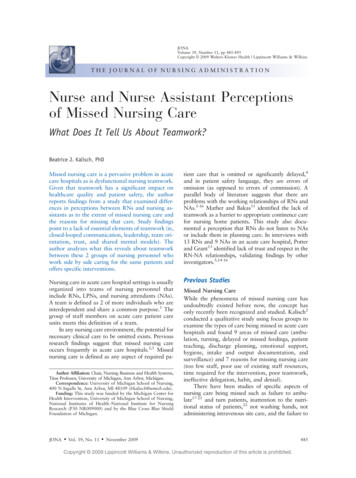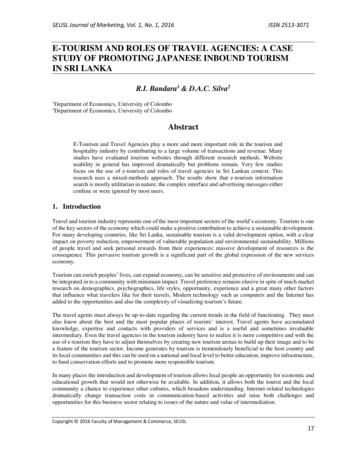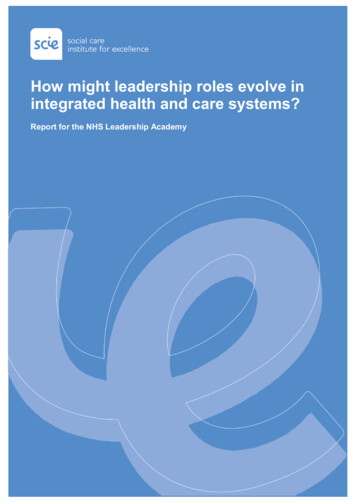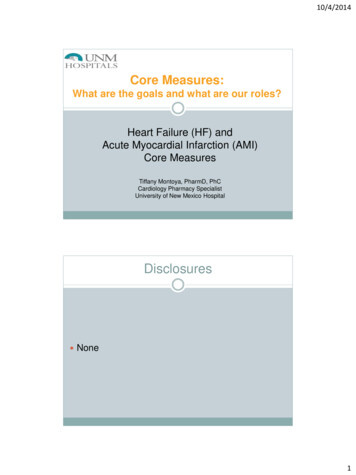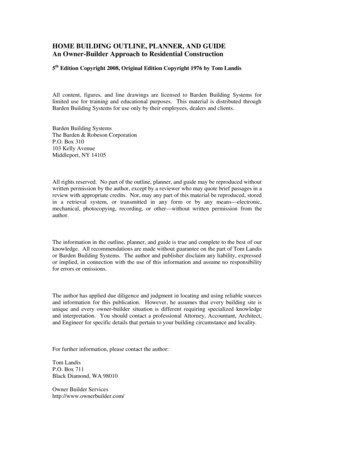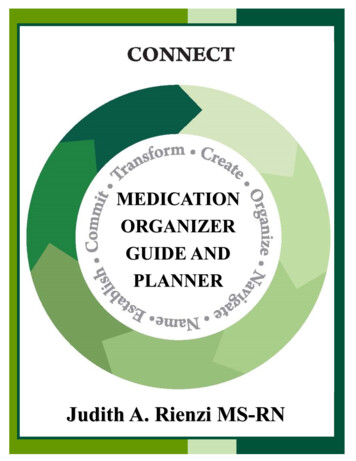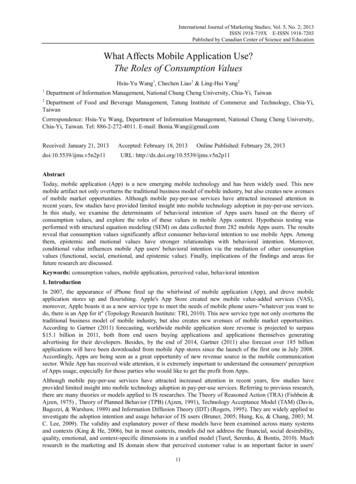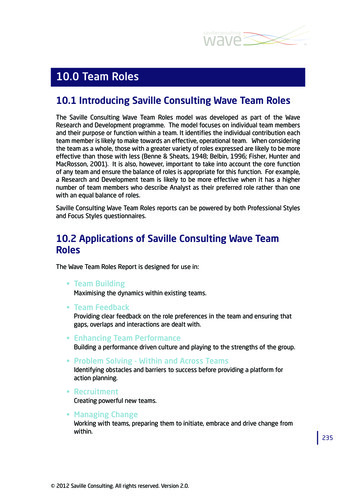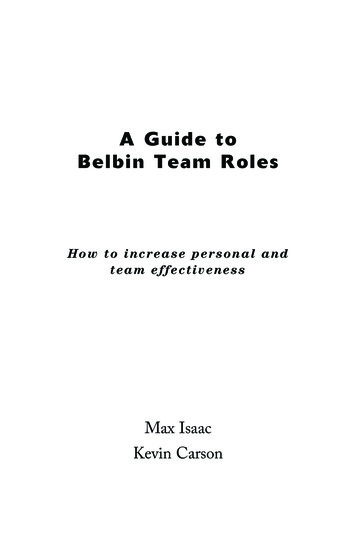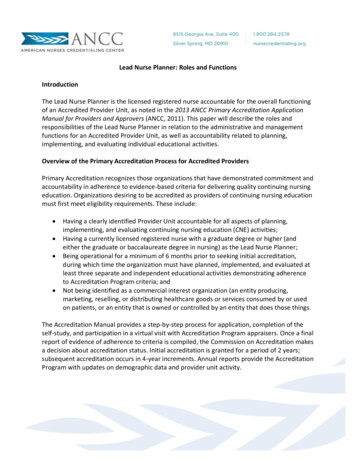
Transcription
Lead Nurse Planner: Roles and FunctionsIntroductionThe Lead Nurse Planner is the licensed registered nurse accountable for the overall functioningof an Accredited Provider Unit, as noted in the 2013 ANCC Primary Accreditation ApplicationManual for Providers and Approvers (ANCC, 2011). This paper will describe the roles andresponsibilities of the Lead Nurse Planner in relation to the administrative and managementfunctions for an Accredited Provider Unit, as well as accountability related to planning,implementing, and evaluating individual educational activities.Overview of the Primary Accreditation Process for Accredited ProvidersPrimary Accreditation recognizes those organizations that have demonstrated commitment andaccountability in adherence to evidence-based criteria for delivering quality continuing nursingeducation. Organizations desiring to be accredited as providers of continuing nursing educationmust first meet eligibility requirements. These include:Having a clearly identified Provider Unit accountable for all aspects of planning,implementing, and evaluating continuing nursing education (CNE) activities;Having a currently licensed registered nurse with a graduate degree or higher (andeither the graduate or baccalaureate degree in nursing) as the Lead Nurse Planner;Being operational for a minimum of 6 months prior to seeking initial accreditation,during which time the organization must have planned, implemented, and evaluated atleast three separate and independent educational activities demonstrating adherenceto Accreditation Program criteria; andNot being identified as a commercial interest organization (an entity producing,marketing, reselling, or distributing healthcare goods or services consumed by or usedon patients, or an entity that is owned or controlled by an entity that does those things.The Accreditation Manual provides a step-by-step process for application, completion of theself-study, and participation in a virtual visit with Accreditation Program appraisers. Once a finalreport of evidence of adherence to criteria is compiled, the Commission on Accreditation makesa decision about accreditation status. Initial accreditation is granted for a period of 2 years;subsequent accreditation occurs in 4-year increments. Annual reports provide the AccreditationProgram with updates on demographic data and provider unit activity.
Communication and Accountability within an Accredited Provider UnitThe Lead Nurse Planner functions within the Accredited Provider Unit, which operates underthe auspices of the American Nurses Credentialing Center’s Accreditation Program. The ANCCCommission on Accreditation sets standards and criteria for continuing nursing education, inaddition to governance of Accreditation Program activities. The chain of communication forsharing of information goes from the ANCC Accreditation Program to the Lead Nurse Planner ofthe Accredited Provider Unit. In some Accredited Provider Units, there is only one NursePlanner. In other Provider Units, there are multiple Nurse Planners. In this case, otherappropriately qualified nurses (licensed registered nurses with a minimum of a baccalaureatedegree in nursing) are appointed to the role of “Nurse Planner” and operate under theleadership of the Lead Nurse Planner. Ultimately, the goal of the Accredited Provider Unit is toachieve quality outcomes that are of value to learners, organizational leaders, and otherstakeholders in the continuing education process. The following model depicts thesecommunication pathways.ANCC Accreditation ProgramAccredited Provider Lead Nurse PlannerAccredited Provider Nurse Planners (if applicable)Stakeholders in the Continuing Nursing Education processWhat Is An Accredited Provider Unit?An Accredited Provider Unit is an entity that exists for the purpose of providing continuingnursing education to registered nurses. The Accredited Provider Unit may be free-standing. Anexample would be a company that is formed specifically for the purpose of providing continuing
nursing education. The company has no other products or services. In other cases, the ProviderUnit may be part of a larger entity. Here, the larger entity has multiple functions. Examplesmight include a Provider Unit based in a college of nursing or a hospital. Both the college ofnursing and the hospital have many functions. The Provider Unit is a subset of eitherorganization. A hospital may have a staff development department which has responsibility fororientation and continuing education. The part of the department that does continuingeducation is the Provider Unit. In the college of nursing example, the college may havefunctions of undergraduate education, graduate education, and continuing education. The partof the college that does continuing education is the Provider Unit.The Lead Nurse Planner as a Nursing Professional Development SpecialistLead Nurse Planners are accountable for operation of their Accredited Provider Units. As such,they are truly specialists in what they do. The American Nurses Association (ANA) and theNational Nursing Staff Development Organization (NNSDO – now known as the Association forNurses in Professional Development) have collaborated in developing and publishing theNursing Professional Development Scope and Standards of Practice (2010). The realm of nursingprofessional development encompasses continuing education as well as orientation and otheraspects of life-long learning for registered nurses.QualificationsThe Lead Nurse Planner is required to be a registered nurse with an active, unencumberedlicense. This person is required to have a minimum of a graduate degree, with either thebaccalaureate or graduate degree in nursing. Additionally, the Lead Nurse Planner should haveeducation and/or experience in adult education and must be knowledgeable about thefunctions and expectations of an Accredited Provider Unit and the Lead Nurse Planner role.Lead Nurse Planner RolesLeaderThe Lead Nurse Planner is the leader of the Accredited Provider Unit. He or she is accountablefor all processes and outcomes of the Provider Unit, and carries out leadership roles andfunctions to support its work. In the leadership role, the Lead Nurse Planner modelsprofessionalism and exemplifies standards of quality in the work he or she performs. The
Nursing Professional Development: Scope and Standards of Practice document identifies theseamong the leadership characteristics for a nursing professional development specialist:Supports healthy work environments in both education and practiceExhibits creativity and flexibilityCreates a practice culture supportive of innovationAdvocates for nursing and the professional development of nursesMentors othersDemonstrates passion and enthusiasm. (p. 42)AdvocateThe Lead Nurse Planner is a key advocate for the Provider Unit. Interfacing with organizationaladministration and others, the Lead Nurse Planner works to be sure the Provider Unit has thestructural capacity and resources to carry out its functions in order to achieve its goals.Additionally, the Lead Nurse Planner advocates for nursing. He or she may work with others,such as risk managers or quality improvement teams, to advocate for changes in nursingeducation and practice that will enhance quality patient care. The Lead Nurse Plannerchampions the value of continuing nursing education as a contributor to recruitment andretention of nurses who appreciate practicing within a culture that fosters professionaldevelopment.EducatorNot to be forgotten among the other roles of the Lead Nurse Planner is that of educator. TheLead Nurse Planner may serve directly in the educator role or may assist and mentor others inthat role. The Lead Nurse Planner is expected to be knowledgeable in the area of adult learningand to be able to assess needs; analyze gaps in knowledge, skill, or practice; plan andimplement learning activities; and evaluate outcomes. The Lead Nurse Planner needs to beaware of changes in the learning and practice environments that affect learning and learningneeds and must be supportive of organizational changes that promote implementation of newlearning in practice. The Lead Nurse Planner needs to be creative in developing learningactivities in modalities that most effectively meet the needs of the target audience served bythe Provider Unit.
MentorThe Lead Nurse Planner serves as a mentor to other nurses and other healthcare teammembers. The Lead Nurse Planner, advocating for the role of the nurse in promoting qualitypatient care, mentors other nurse educators in helping them develop learning activities thatwill enhance the professional development of nurse learners. The Lead Nurse Planner alsoencourages other Nurse Planners and Nurse Educators to continue their own education andprofessional development. He or she stays abreast of evidence-based practice and bestavailable evidence from research data and other sources to guide development of educationalactivities that will facilitate quality nursing practice.EvaluatorThe Lead Nurse Planner is involved in evaluation in several ways. First, this person participatesin evaluation of individual learning activities in which he or she functioned as the NursePlanner. This first-hand view helps the Nurse Planner look at the effectiveness of the learningactivity in achieving its purpose. Factors that might be considered if the learning activity isrepeated can be addressed through this review, and issues that might have an impact on otherlearning activities can be addressed. Second, the Lead Nurse Planner is engaged in review ofevaluation data from other learning activities conducted by the Provider Unit. The Lead NursePlanner helps the other Nurse Planner(s) who were involved in a learning activity evaluate itsmerits and opportunities for improvement. In this way, he or she gets a feel for theeffectiveness of the Provider Unit's activities. Third, the Lead Nurse Planner assumes theprimary role in evaluation of the Provider Unit itself. He or she involves other stakeholders inthat process, but the Lead Nurse Planner drives the process. Specific details of the Provider Unitevaluation process are identified in a later section of this document.CollaboratorThe Lead Nurse Planner does not function in a vacuum. The Lead Nurse Planner collaborateswith other nurses and other members of the healthcare team. This person may representnursing in planning an interprofessional conference for nurses, physicians, social workers, andothers. He or she may be engaged as a member of a quality improvement team working toprovide education and resources needed for direct care providers to help them practiceaccording to evidence-based standards. The Lead Nurse Planner may collaborate with othergroups, such as specialty nursing organizations, chapters, or community nursing groups, to
conduct needs assessments and facilitate learning that will benefit nurses in community-basedsettings.LearnerThe Lead Nurse Planner must continue his or her own professional development as well asfostering professional development in others. This can be accomplished through activities suchas attending continuing education sessions or regional/national conferences for nurseeducators. Learning about new technology and how to incorporate new ways of learningappropriate for the Provider Unit's target audience is one example of a way the Lead NursePlanner's learning can contribute to successful evolution of the Provider Unit. Membership inrelevant national nursing organizations also provides the Lead Nurse Planner with personalconnections and resource materials that can enhance his or her professional growth. The LeadNurse Planner may also consider advanced academic education in nursing, adult education, oranother relevant field of study. Keeping up-to-date is critical to being successful in the role ofLead Nurse Planner.Lead Nurse Planner ResponsibilitiesMaintaining Active LicensureThe Lead Nurse Planner is required to be a registered nurse with a minimum of a graduatedegree. Either the graduate or baccalaureate degree must be in nursing. Active licensure as aregistered nurse is required. The license should be unencumbered, meaning that there are nocurrent disciplinary actions on that license.Keeping Current with CriteriaThe Lead Nurse Planner is accountable for consistent implementation of Accreditation Programcriteria for operations as an Accredited Provider Unit. That means that the Lead Nurse Plannerneeds to know and use the resources and tools for keeping up-to-date on requirements andchanges in criteria. The Lead Nurse Planner functions as the liaison between the ANCCAccreditation Program Office and the Nurse Planners or other key personnel in the AccreditedProvider Unit.One tool that can be used to keep current is the website of the Accreditation ation/Primary). The Accreditation Program Office
provides information about changes, operation of an Accredited Provider Unit, frequently askedquestions, and resources.Another resource for keeping current with criteria is the director of the Accreditation Program.Emails (accreditation@ana.org) or telephone calls (1.800.284.2378) to the ANCC AccreditationProgram Office may help to resolve issues or answer questions about which the Lead NursePlanner is unsure.The Accreditation Program also publishes regular director’s updates and holds workshops toprovide information and updates to accredited organizations. Taking advantage of theseopportunities will help the Accredited Provider Unit’s Lead Nurse Planner have currentinformation for his or her own work as well as to keep other Nurse Planners in the Provider Unitup-to-date.Accreditation criteria are designed around a model for continuing nursing education as oneaspect of nursing professional development, consistent with the nursing professionaldevelopment model in the Nursing Professional Development: Scope and Standards of Practice(ANA & NNSDO, 2010). The three key components of the accreditation model are structuralcapacity, educational design, and quality outcomes (ANCC, 2011). The Lead Nurse Planner isaccountable for ensuring that all elements of each criterion are consistently met during theperiod of accreditation and is required to document sources of evidence for each criterion attime of submission of a new provider self-study.
Keeping Current with State Board of Nursing RulesIn addition to the national criteria for continuing nursing education published by the ANCCAccreditation Program, some state boards of nursing also have rules regulating the provision ofcontinuing nursing education within their states. It is imperative for the Lead Nurse Planner tobe familiar with these rules and stay current on any changes that occur. State board rules maybe added to requirements of an Accredited Provider but cannot replace adherence to theAccreditation criteria.In addition, some state boards of nursing have regulatory authority over licensees or certificateholders other than registered nurses. An Accredited Provider Unit in one of these states mayalso be looking at providing continuing education for other groups, such as licensed practicalnurses and technicians. Nothing prohibits an Accredited Provider Unit from doing this, butevaluation of Provider Unit actions by Accreditation appraisers will occur in relation to theprovider’s ability to carry out the criteria and requirements specific to the registered nurselearner.Administering the Provider UnitThe Lead Nurse Planner is charged with the responsibility of ensuring that the AccreditedProvider Unit operates according to Accreditation Program criteria. All administrative functionsof the Provider Unit, within the parameters established by the employer, are the responsibilityof the Lead Nurse Planner. For example, the Lead Nurse Planner may not have the authority tohire and fire personnel, but he or she does have the accountability to orient new NursePlanners and to intervene when someone in the Provider Unit is not adhering to criteria incarrying out assignments. The Lead Nurse Planner may not have the ability to write newposition descriptions but can advocate for a change in a position description that is notconsistent with Accreditation Program criteria and standards. Whereas the Lead Nurse Plannermay be accountable to a manager or director in the organization as far as employmentreporting is concerned, he or she is also accountable to the Accreditation Program Office toensure effective operation of the Provider Unit. Failure to do so may result in suspension orrevocation of Accredited Provider status.
Assessing Structural CapacityStructural capacity of the Accredited Provider Unit refers to the organizational structure withinwhich the Provider Unit operates, the resources and support provided by the organization forProvider Unit functions, and the ability of the Provider Unit to achieve its desired outcomes.Questions the Lead Nurse Planner needs to ask in conducting this assessment include:How do I, as the leader of the Provider Unit, demonstrate commitment to the needs ofthe learners we serve?How has our Provider Unit modified our processes based on evaluation and feedbackfrom learners?How am I supported by my organization’s leadership in achieving our goals?How do I orient new Nurse Planners and other key people in the Provider Unit?How do I make sure everyone in my Provider Unit adheres to Accreditation Programcriteria?How do I resolve issues and challenges in the Provider Unit?How do I connect with the Accreditation Program Office and website to keep up-todate?How do I make sure the Provider Unit has the resources it needs?These are the types of questions that the Lead Nurse Planner will need to answer whencompleting the accreditation self-study, and they should be questions that guide the work ofthe Provider Unit on an on-going basis.Goal Setting: Determining Quality OutcomesThe Lead Nurse Planner has responsibility for setting the goals for the Provider Unit. This work isusually not done in isolation, but is a collaborative effort of everyone involved. However,ultimate accountability rests with the Lead Nurse Planner. Note that the focus here is on
establishing goals for the Provider Unit itself, not for the individual learning activities that aredeveloped and implemented by the Provider Unit. Each of those activities will have its ownpurpose and desired outcome. Collectively, the learning activities should all be carried out tohelp the Provider Unit achieve its overarching goals.The purpose of continuing nursing education is to enhance the professional development of theregistered nurse and to contribute to quality patient care. Unique goals will exist for differenttypes of Provider Units, but they all should be compatible with this overall purpose. Goalsshould be expressed as outcome statements, indicating measureable standards to demonstratethe successes of the Provider Unit’s endeavors.A Provider Unit’s Lead Nurse Planner might consider several quality outcome measures. Asuggested list is provided in the Accreditation Manual (ANCC, 2011) and partially includes:Cost savings for customers (the customer may be the individual learner, a nursingdepartment, or the facility itself)Cost savings for the Provider Unit (operating effectively and efficiently to maximize useof resources)Volume of participants for learning activities (increasing use of educational activities byproviding the types of activities learners want and need)Volume of educational activities provided (increase or decrease, based on learner andfacility need)Change in format of learning activities (as an example, more focus on e-learning basedon needs assessments of a younger generation of learners)Change in operations to achieve strategic goals (maybe adding an AV technician or webmaster to the Provider Unit team)Turnover rate for staff in the Provider Unit (p
nursing education. The company has no other products or services. In other cases, the Provider Unit may be part of a larger entity. Here, the larger entity has multiple functions. Examples might include a Provider Unit based in a college of nursing or a hospital. Both the college of
